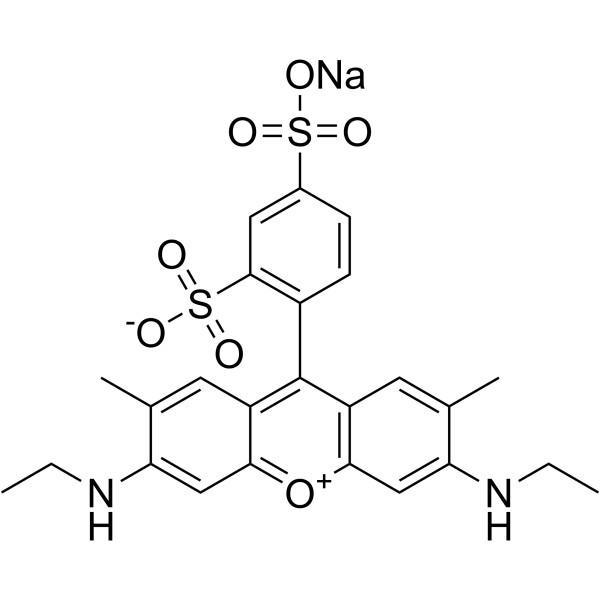hydrogen 9-(2,4-disulphonatophenyl)-3,6-bis(ethylamino)-2,7-dimethylxanthylium, monosodium salt

hydrogen 9-(2,4-disulphonatophenyl)-3,6-bis(ethylamino)-2,7-dimethylxanthylium, monosodium salt structure
|
Common Name | hydrogen 9-(2,4-disulphonatophenyl)-3,6-bis(ethylamino)-2,7-dimethylxanthylium, monosodium salt | ||
|---|---|---|---|---|
| CAS Number | 5873-16-5 | Molecular Weight | 552.59500 | |
| Density | N/A | Boiling Point | N/A | |
| Molecular Formula | C25H25N2NaO7S2 | Melting Point | N/A | |
| MSDS | Chinese USA | Flash Point | N/A | |
Use of hydrogen 9-(2,4-disulphonatophenyl)-3,6-bis(ethylamino)-2,7-dimethylxanthylium, monosodium saltSulforhodamine G is a fluorescent stain with broad dynamic ranges. Sulforhodamine G can be used for the research of protein stains[1]. |
| Name | sulforhodamine G |
|---|---|
| Synonym | More Synonyms |
| Description | Sulforhodamine G is a fluorescent stain with broad dynamic ranges. Sulforhodamine G can be used for the research of protein stains[1]. |
|---|---|
| Related Catalog | |
| In Vitro | Guidelines (Following is our recommended protocol. This protocol only provides a guideline, and should be modified according to your specific needs). Labeling of fluorescent internal protein: A. Prepared of protein samples: 1. Protein samples to be analyzed are spiked with 0.1% of the total protein load of ALIS647 (ALIS internal standard) prior. 2. Protein sample is separated with 2-DE in the dark. B. Purify Sulforhodamine G: 1. Sulforhodamine G (60% purity, 10 mg) dissolved in 100 mL of 1% v/v acetic acid to purify by RP chromatography. 2. Collect the pool with an absorbance maximum at 528 nm, lyophilized to dryness and stored as a dry powder at 47℃. C. Stainning: 1. staining was performed in polypropylene staining dishes wrapped in aluminum foil to prevent photobleaching of the stains. 2. Sulforhodamine G staining is performed overnight in 35% methanol with a four-fold molar excess of dye: protein based on an average protein molecular weight of 50 kDa. 3. Following 4×15 min washes in 35% methanol and 2×15 min equilibrations in water. 4. Total protein and ALIS are visualized with a laser scanner using different channels. 5. Protein spots visualized using total protein stain (λex=532 nm) and ALIS (λex=633 nm) are quantified separately using 2-DE software, and statistical analysis. |
| References |
| Molecular Formula | C25H25N2NaO7S2 |
|---|---|
| Molecular Weight | 552.59500 |
| Exact Mass | 552.10000 |
| PSA | 165.86000 |
| LogP | 6.55920 |
| Personal Protective Equipment | Eyeshields;Gloves;type N95 (US);type P1 (EN143) respirator filter |
|---|---|
| Hazard Codes | F |
| RIDADR | NONH for all modes of transport |
| WGK Germany | 3 |
|
Synthesis and applications of Rhodamine derivatives as fluorescent probes.
Chem. Soc. Rev. 38(8) , 2410-2433, (2009) Rhodamine dyes are widely used as fluorescent probes owing to their high absorption coefficient and broad fluorescence in the visible region of electromagnetic spectrum, high fluorescence quantum yiel... |
|
|
Sequential transcription factor targeting for diffuse large B-cell lymphomas.
Cancer Res. 68(9) , 3361-9, (2008) Transcription factors play a central role in malignant transformation by activating or repressing waves of downstream target genes. Therapeutic targeting of transcription factors can reprogram cancer ... |
|
|
Fluorescent dye and media properties affecting sorption and tracer selection Kasnavia, T., Vu, D., & Sabatini, D. A.
Groundwater 37(3) , 376-381, (1999)
|
| SULFORHODAMINE G |
| C.I. Acid Red 50 |
| Sulforhodamin G |
| Acid Pink G |
| innersalt,monosodiumsalt |
| EINECS 227-528-6 |
| SulphorhodamineG |
| acid red 50 |
| Sulforhodamine G,Acid Red 50 |
| MFCD00213704 |